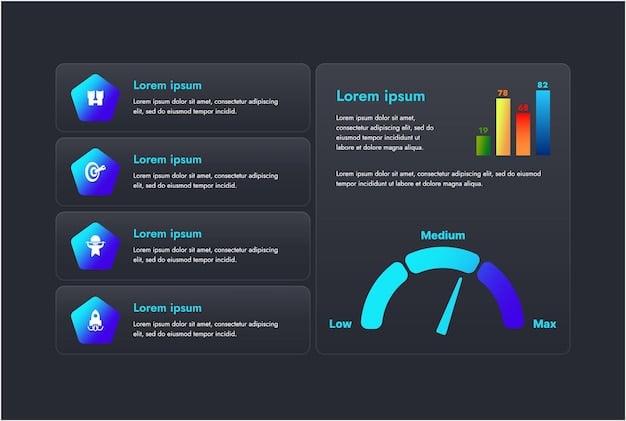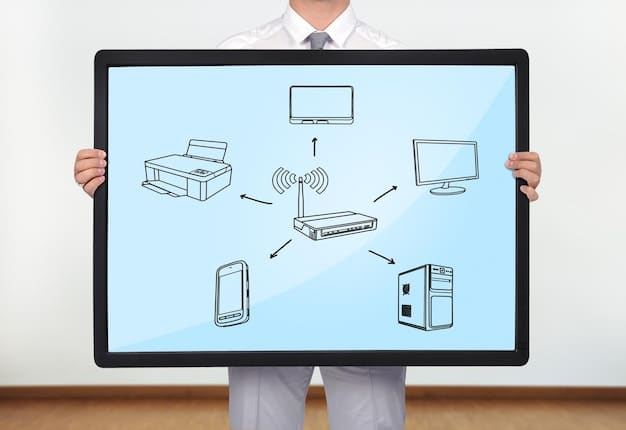Is Your Internet Fast Enough? Optimize Your Connection for PC Gaming

Is your internet fast enough for PC gaming? Optimizing your internet connection to ensure a lag-free gaming experience involves several key steps, including assessing your current speed, understanding bandwidth requirements, upgrading hardware, and prioritizing gaming traffic.
Is your gaming session constantly interrupted by lag spikes or frustratingly slow loading times? One of the most critical factors in enjoying a seamless PC gaming experience is having a fast and stable internet connection. Let’s explore how to optimize your internet for lag-free PC gaming.
Understanding Internet Speed and Gaming
When it comes to PC gaming, not all internet connections are created equal. Understanding the key metrics that impact your gaming experience is the first step in ensuring you have a sufficiently fast and reliable connection. Bandwidth, speed tests and ping are critical. Let’s define download and upload speeds.
Download Speed vs. Upload Speed
Download speed is how fast you can receive data from the internet, while upload speed is how fast you can send data. Games require both, but download speed is generally more critical for receiving game data, updates, and streaming content.
Upload speed is essential for transmitting your actions to the game server and for activities like streaming your gameplay. Here’s a good explanation:
- Download Speed: Measured in Mbps (megabits per second), this determines how quickly you can download game files, updates, and receive data from game servers.
- Upload Speed: Also measured in Mbps, this affects how quickly you can send data to game servers, crucial for actions in online games and streaming.
- Ping: Measured in milliseconds (ms), ping is the reaction time of your connection – how quickly your device receives a response after you’ve sent out a request. Lower ping means less lag.
Understanding the difference between download and upload speeds is crucial. While download speed is essential for receiving game data and updates, upload speed is critical for transmitting your actions to the game server. A balanced connection ensures smooth gameplay.
Assessing Your Current Internet Speed
Before making any changes, it’s essential to know your current internet speed. This involves running a speed test to determine your download speed, upload speed, and ping. This will help you identify any discrepancies between what you’re paying for and what you’re actually getting.

Here’s how to check your speed:
Running a Speed Test
Several free online tools can help you assess your internet speed. Popular options include Speedtest by Ookla and Google’s Speed Test. These tests provide a comprehensive overview of your connection’s performance.
The speed test will provide insights into the performance of your connection:
- Visit a Speed Test Website: Go to Speedtest.net or use Google’s built-in speed test by searching “internet speed test.”
- Start the Test: Click the “Go” button to begin the test. The tool will measure your download speed, upload speed, and ping.
- Analyze Results: Compare the results with your internet plan’s promised speeds. Note any discrepancies.
Speed tests are usually free and easy to use. Run several tests at different times of the day to get a sense of average performance. This can help you identify peak hours when your internet may be slower due to network congestion.
Understanding Bandwidth Requirements for PC Gaming
Different games have different bandwidth requirements. Understanding these requirements is crucial for ensuring your internet connection can handle your gaming needs. The bandwidth needs for PC games can vary significantly. Here is some useful information.
Typical Bandwidth Requirements for Popular Games
Online multiplayer games generally require a stable and fast connection. Popular titles like “Fortnite,” “Call of Duty,” and “Overwatch” typically need at least 3-5 Mbps download and 1-3 Mbps upload speeds for smooth gameplay. However, these are just minimums.
Considerations about online games:
Some games may require higher bandwidth, especially if you’re streaming your gameplay simultaneously. Here’s a quick list:
- Minimum Requirements: Usually around 3-5 Mbps download and 1-3 Mbps upload.
- Recommended Requirements: Aim for at least 10-20 Mbps download and 5-10 Mbps upload for a buffer.
- Streaming Gameplay: Add an additional 5-10 Mbps upload speed to handle the streaming without impacting gameplay.
For optimal performance, it’s best to have more bandwidth than the minimum requirements. This provides a buffer and ensures your gaming experience isn’t affected by other devices using the internet at the same time.
Upgrading Your Hardware for Better Performance
Sometimes, the issue isn’t your internet speed but the hardware you’re using. Outdated or inadequate hardware can limit your connection’s performance and cause lag. Make sure you have the right gear.
Router and Modem
Your router and modem are the gateways to your internet connection. Upgrading to a newer, more powerful model can significantly improve your gaming experience. A good router should support the latest Wi-Fi standards (such as Wi-Fi 6) and have features like QoS (Quality of Service) to prioritize gaming traffic.
New hardware can result in huge benefits:
- Wi-Fi Standards: Ensure your router supports the latest Wi-Fi standards like 802.11ax (Wi-Fi 6) or 802.11ac (Wi-Fi 5) for faster and more reliable connections.
- QoS Feature: Enable Quality of Service (QoS) in your router settings to prioritize gaming traffic over other devices.
- Consider a Gaming Router: These routers are designed specifically for gaming, with advanced features like traffic prioritization and low latency.
Investing in a quality router and modem can make a significant difference. Look for models with positive reviews and features tailored to gaming for the best results.
Prioritizing Gaming Traffic with QoS
Quality of Service (QoS) is a feature available on many routers that allows you to prioritize certain types of traffic over others. By prioritizing gaming traffic, you can ensure your game receives the bandwidth it needs, even when other devices are using the internet.

Here is some more detail on QoS:
How to Configure QoS on Your Router
The process for configuring QoS varies depending on your router’s manufacturer. Generally, you’ll need to access your router’s settings through a web browser, locate the QoS settings, and then prioritize gaming traffic. This involves identifying the ports used by your game and assigning them a higher priority.
Consider applying these improvements:
- Access Router Settings: Type your router’s IP address into a web browser to access the settings page (usually found on a sticker on the router).
- Locate QoS Settings: Look for “QoS,” “Quality of Service,” or “Traffic Prioritization” in the settings menu.
- Prioritize Gaming Traffic: Add your gaming device or the specific ports used by your games to the high-priority list.
Configuring QoS can significantly reduce lag and improve your gaming experience, especially when multiple devices are connected to your network simultaneously.
Optimizing Your Network Settings
In addition to upgrading hardware and prioritizing traffic, several software-level optimizations can help improve your internet connection for gaming. This includes tweaking your network settings and closing unnecessary background applications.
Closing Unnecessary Background Applications
Many applications running in the background can consume bandwidth and slow down your internet connection. Closing these applications can free up resources and improve your ping and download speed. Common culprits include file-sharing programs, streaming services, and automatic update services.
Adjusting In-Game Settings
In-game network settings, such as choosing the closest server, can also impact performance. Adjust display settings and resolution to achieve higher frame rates.
- Update Drivers: Keep your network adapter drivers up to date.
- Optimize DNS Settings: Switch to a faster DNS server like Google DNS or Cloudflare DNS.
- Limit Background Apps: Close unnecessary applications to free up bandwidth.
These optimizations require some technical knowledge but can yield noticeable improvements in your gaming experience. Remember to back up any settings before making changes so you can revert if necessary.
| Key Point | Brief Description |
|---|---|
| 📶 Assess Speed | Run a speed test to check download, upload, and ping. |
| 🎮 Bandwidth Needs | Know the minimum and recommended bandwidth for your games. |
| ⬆️ Upgrade Hardware | Consider a new router or modem. |
| 🚦 Prioritize Traffic | Enable QoS to prioritize gaming traffic. |
FAQ
▼
A ping of 50ms or less is generally considered ideal for gaming, providing a smooth and responsive experience. Anything below 100ms is usually playable, but higher than that may result in noticeable lag.
▼
Online gaming typically uses between 3-5 Mbps download and 1-3 Mbps upload speeds. However, some games may require more. Streaming your gameplay will significantly increase the upload bandwidth needed.
▼
Yes, a better router can improve your ping. Upgrading to a router with faster processing power and advanced features like QoS can help prioritize gaming traffic and reduce latency.
▼
Ethernet is generally better for gaming because it provides a more stable and reliable connection with lower latency compared to Wi-Fi. Wi-Fi can be convenient, but it’s more prone to interference and fluctuations.
▼
If your internet speed is too slow, consider upgrading to a faster internet plan, optimizing your network settings, closing unnecessary background applications, and upgrading your router and modem to improve overall performance.
Conclusion
Optimizing your internet connection for lag-free PC gaming involves several key steps, from assessing your current speed and understanding bandwidth requirements to upgrading hardware and prioritizing gaming traffic. By implementing these strategies, you can significantly improve your gaming experience and enjoy smoother, more responsive gameplay.





